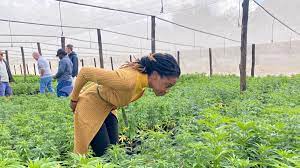

HEMP – a low type of Cannabis sativa with a low level of the Unnibinoid THC – is a wind – pollinated, annual broad-leaf plant with a taproot. It is cultivated for its production of long fibers for textiles, hemp seeds for oil and other uses.
Most of Africa’s climate is favorable to cannabis cultivation. The plant likes warm and sunny weather and does not do so well in the cold. Certain cannabis strains can also thrive in extreme heat. Some growing techniques such as dry farming allows farmers to grow the crop using mostly rainfall with minimal additional watering if the climate conditions are right. Drip irrigation is also a cheap and efficient way to water cannabis crops in Africa.
The cannabis plant grows in stages. First come the initial germination and seeding. Then, the plant enters the vegetative phase and produces most of its leaves and branches. After several weeks, the plant can enter the flowering stage. If the plant is a male plant, it will grow pollen sacks. If it is a female plant, it will produce flowers (buds) that can be smoked or processed into tinctures and oils.
Up until 29/10/2021, it was illegal to grow hemp in SA. After careful consideration, the Minister of Agriculture, Land Reform and Rural Development announced the opening of the application process for Hemp and Cannabis permits. This means that Agripreneurs/farmers are now able to apply for a permit to farm hemp and cannabis as an “agricultural” crop.
ARE HEMP AND CANNABIS THE SAME THING?
Hemp and Cannabis (marijuana) are not the same things. Although they fall under the same genus, Cannabis, Hemp (Cannabis savita L) is very much for “industrial ” or agricultural use, whereas marijuana (also known as dagga) can be used for “medicinal” or recreational purposes. The following options are available for interested agripreneurs/farmers:
- Cannabis farmer – growing and cultivating hemp.
- CBD or Hemp manufacturer – this could include producing CBD Oils or Hemp textiles.
- CBD or Hemp product developer – creating products using CBD Oils or Hemp textiles.
- Hemp or CBD product distributor – selling CBD or Hemp products to consumers.
SOIL PREPARATION
Hemp and Cannabis grows best in well – drained loam soil with a pH of between 6 and 7.5 with abundant organic matter – at least 3,5%. Dense, poorly- drained clay soil is not suitable and sandy soil’s need for extra irrigation and fertilization may be uneconomical. Seedbed preparation is important; firm and fine is best in order to plant hemp/cannabis seeds between 203 cm deep. Hemp is sensitive to frost during germination and requires water during the first 6 weeks after planting.
HARVESTING
Harvesting hemp for fiber is easier than harvesting hemp for the hemp seed. To harvest hemp grown for fiber, implements used for the harvesting of forage crops can be used, which perform well without major modifications. A straight sickle mower is the most suitable for harvesting hemp for textile applications. This implement leaves cut stems intact, laid neatly and organized directly on the ground. Haybines do not work well as the long stems wrap on the reel. Cut no shorter than 10cm above the soil surface.

